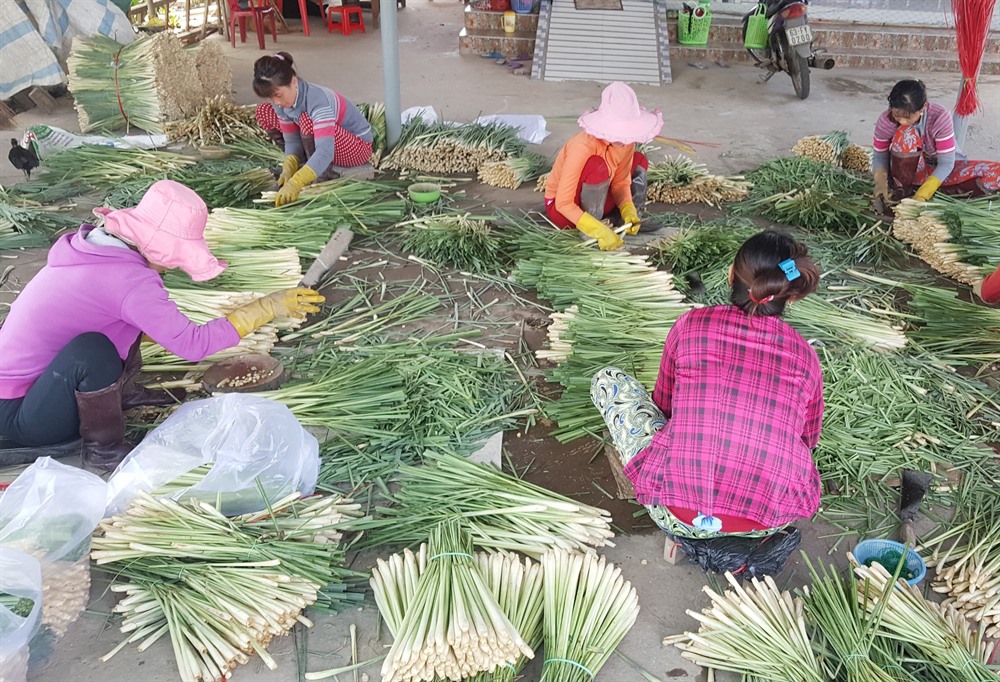 Society
Society

Farmers in Tiền Giang Province’s Tân Phú Đông District have turned nearly 500ha of low-yielding rice paddies into lemongrass and soursop farms because of saltwater intrusion and drought.
 |
| Farmers in Tiền Giang Province’s Tân Phú Đông District categorise lemongrass they have harvested before selling them to traders. – VNA/VNS Photo Nam Thái |
TIỀN GIANG – Farmers in Tiền Giang Province’s Tân Phú Đông District have turned nearly 500ha of low-yielding rice paddies into lemongrass and soursop farms because of saltwater intrusion and drought.
The two crops can tolerate high levels of salt.
The rice paddies used to yield only one rice crop each year in the rainy season because of the saltwater and drought in the dry season.
Now farmers grow lemongrass on 360ha and soursop on the rest.
Besides being hardy, they also offer high yields and are in great demand in the market.
Nguyễn Văn Sum, who grows lemongrass on his 0.7ha of rice paddy in Tân Phú Đông’s Phú Thạnh Commune, said lemongrass is easy to grow and suits the soil and harsh conditions in the district.
He harvests around 30 tonnes a year and earns VNĐ50 million (US$2,150) a year, many times the money he would make from rice, helping his family escape poverty, he said.
Lê Hồng Đáng of Tân Phú Đông’s Phú Đông Commune has converted his 5,000sq.m rice field into a soursop orchard.
It gives high yields of 5-7 tonnes of fruits a year and he earns VNĐ70 million ($3,020), he said.
He has also taught dozens of poor rice farmers in the neighbourhood how to grow soursop and helped them switch.
Phú Thạnh and Phú Đông are the most affected in the district by saltwater intrusion and drought. Previously farmers would grow one rice crop in the rainy season and leave the field fallow in the dry season.
The district is located at the end of the Tiền River, a tributary of the Mekong, and is badly affected by saltwater intrusion as a result when the water flows backwards in the dry season.
Under the district’s agricultural restructuring plan in the period to 2020, it is identifying crops that can adapt to saltwater and drought and provide high incomes such as lemongrass and soursop.
The district has about 1,500ha under lemongrass and an annual output of 22,000 tonnes.
It is planted in fields, embankments, along roads and around houses in the district.
Some farmers still rotate between lemongrass and rice while others have given up rice.
The district had nearly 1,000ha under soursop as of the middle of last year compared to 600ha in 2015, according to its Agriculture and Rural Development Division.
The fruit provides some 10 times the income as rice, it said.
Soursop can be harvested throughout the year.
The district’s soursop is sold in other delta provinces but mostly to HCM City. The fruit is eaten fresh or used to make fruit shakes and jams.
Nguyễn Văn Hải, head of the division, said the district plans to use all low-yield rice fields to grow lemongrass, soursop and other high-value crops that can tolerate the district’s harsh natural conditions next year.
The crops help farmers improve their lives, he said.
The district had more than 3,500 poor households last year, or a 31 per cent rate.
Tân Phú Đông, one of Tiền Giang’s poorest districts, aims to reduce the rate to 19 per cent by next year. – VNS




